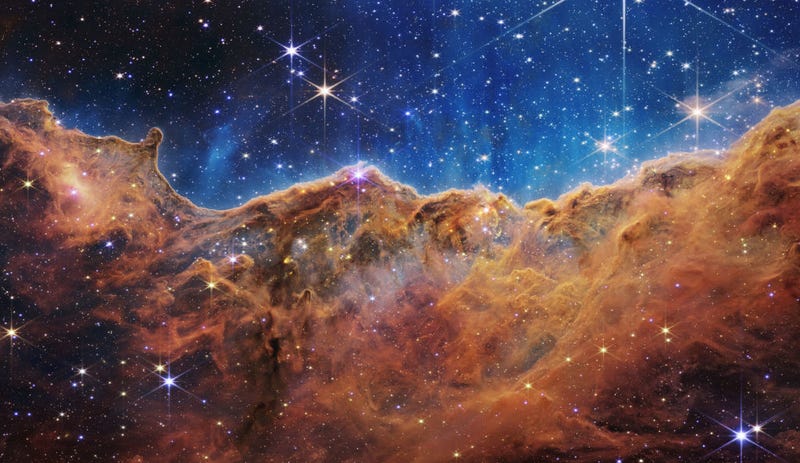
Complex organic molecules have been detected in a galaxy 12 billion light years away from Earth, according to a study published Monday in the Nature journal.
This is the most distant location where these molecules have been found, said a press release from University of Illinois at Urbana-Champaign. Researchers were able to detect them with help from the James Webb Space Telescope.
“Here we present James Webb Space Telescope observations that detect the 3.3 microgram [polycyclic aromatic hydrocarbon] feature in a galaxy observed less than 1.5 billion years after the Big Bang,” said the study abstract. “The high equivalent width of the PAH feature indicates that star formation, rather than black hole accretion, dominates infrared emission throughout the galaxy. The light from PAH molecules, hot dust and large dust grains and stars are spatially distinct from one another, leading to order-of-magnitude variations in PAH equivalent width and ratio of PAH to total infrared luminosity across the galaxy.”
Polycyclic aromatic hydrocarbons “are large organic molecules that trace millimeter-size dust grains and regulate the cooling of interstellar gas within galaxies,” researchers explained. On Earth they can be found in combustion engine exhaust and forest fires.
Professor Joaquin Vieira of the University of Illinois Urbana-Champaign and graduate student Kedar Phadke worked on the project with researchers at Texas A&M University, as well as an international team of scientists.
“This project started when I was in graduate school studying hard-to-detect, very distant galaxies obscured by dust,” Vieira said. “Dust grains absorb and re-emit about half of the stellar radiation produced in the universe, making infrared light from distant objects extremely faint or undetectable through ground-based telescopes.”
For the new study, a phenomenon called “gravitational lensing” helped clear things up.
“This magnification happens when two galaxies are almost perfectly aligned from the Earth’s point of view, and light from the background galaxy is warped and magnified by the foreground galaxy into a ring-like shape, known as an Einstein ring,” Vieira explained.
Viera’s research team focused on SPT0418-47, which was previously identified as a dust-obscured galaxy 12 billion lights years away from our planet. Spectroscopic data indicates that generations of stars have already lived and died in this galaxy due to the presence of heavy elements.
“What this research is telling us right now – and we are still learning – is that we can see all of the regions where these smaller dust grains are located – regions that we could never see before the [James Webb Space Telescope],” Phadke said. “The new spectroscopic data lets us observe the galaxy’s atomic and molecular composition, providing very important insights into the formation of galaxies, their lifecycle and how they evolve.”
Viera said that the unexpected discovery of complex organic molecules so far away is “game-changing,” and will influence future observations.
“This work is just the first step, and we’re just now learning how to use it and learn its capabilities. We are very excited to see how this plays out,” he said.
As news of this discovery broke, The Debrief reported that a former intelligence official turned whistleblower David Charles Grusch had provided Congress and the Intelligence Community Inspector General “extensive classified information about deeply covert programs that he says possess retrieved intact and partially intact craft of non-human origin.”
“Other intelligence officials, both active and retired, with knowledge of these programs through their work in various agencies, have independently provided similar, corroborating information, both on and off the record,” said the report.
However, Department of Defense spokesperson Susan Gough told Fox News Digital in an email Tuesday that there is no “verifiable information to substantiate the claims,” according to the outlet.


